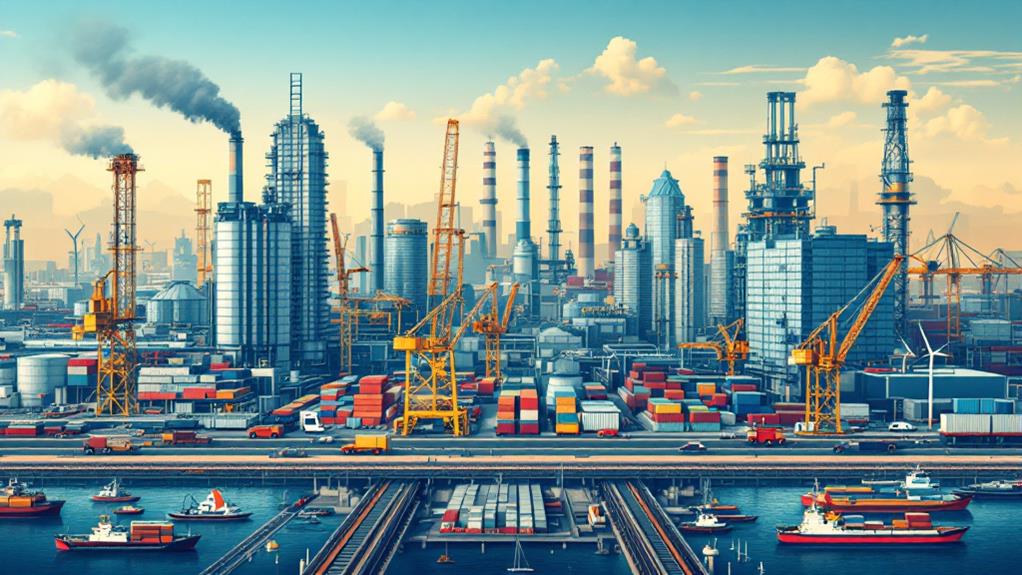Different Sectors for Steel Applications: Where Steel Is Most Commonly Used

Steel's versatility makes it an essential material across multiple sectors. You'll find it extensively used in construction and infrastructure, forming the backbone of buildings, bridges, and transportation systems. The automotive industry relies heavily on steel for vehicle components, prioritizing safety and efficiency. In energy and power generation, steel withstands extreme conditions in power plants and renewable energy structures. Transportation systems, from railways to ships, depend on steel's resilience. You'll encounter steel in everyday appliances and consumer goods, valued for its longevity and affordability. The aerospace and defense sectors employ steel for high-performance applications. Exploring these sectors reveals steel's indispensable role in modern society.
Construction and Infrastructure
Three key areas dominate steel usage in construction and infrastructure: buildings, bridges, and transportation systems. In buildings, you'll find steel in structural frameworks, reinforcing bars, and roofing materials. It's essential for creating strong, durable structures that can withstand various environmental pressures. Residential construction often incorporates steel for its strength-to-weight ratio and versatility.
Bridges rely heavily on steel for their main support structures, cables, and decking. You'll see steel's importance in iconic suspension bridges and practical overpasses alike. Its ability to span long distances makes it indispensable in bridge design and construction.
In transportation systems, steel is critical for railways, subway tunnels, and airport terminals. You'll find it in train tracks, reinforcing underground structures, and forming the skeleton of expansive airport roofs.
Urban planning often revolves around steel's capabilities. It allows for taller buildings, longer bridges, and more efficient transportation networks. As cities grow and evolve, steel continues to play a central role in shaping our built environment, from skylines to subways.
Automotive Industry
Moving from large-scale structures to personal transportation, steel's impact is equally significant in the automotive industry. You'll find steel in nearly every part of your vehicle, from the body and chassis to the engine components. Its strength-to-weight ratio makes it ideal for creating safer, more fuel-efficient cars without compromising performance.
Steel's versatility extends beyond passenger vehicles. In agricultural machinery, you'll see it in the frames of tractors, combines, and other heavy-duty equipment. These machines require durability to withstand harsh conditions and constant use, making steel an essential material.
The shipbuilding industry also relies heavily on steel. From the hull to the superstructure, steel provides the necessary strength to withstand the corrosive effects of saltwater and the immense pressures of the ocean.
In recent years, advanced high-strength steels have revolutionized automotive design. These innovative alloys allow for lighter vehicles with improved crash protection. As the automotive industry shifts towards electric vehicles, steel continues to play a pivotal role in battery protection and overall vehicle structure, adapting to new technological demands while maintaining its position as a cornerstone material.
Energy and Power Generation

Steel's role in energy and power generation can't be overstated. It's a key material in the construction of power plants, wind turbines, and solar panel support structures. You'll find steel components in nearly every stage of electricity generation and power transmission.
In power plants, steel is used for:
- Boilers and pressure vessels
- Turbine casings and rotors
- Generators and transformers
Steel's strength and durability make it ideal for withstanding high temperatures and pressures in these applications. It's also essential in the construction of transmission towers and power lines, ensuring electricity reaches homes and businesses efficiently.
In renewable energy, steel plays a fundamental role. Wind turbine towers and nacelles rely on steel for their structural integrity. Solar farms use steel frames to support panels and track the sun's movement. Even in hydroelectric power generation, steel is used in dam construction and turbine components.
You'll also find steel in oil and gas extraction equipment, pipelines, and storage tanks. Its corrosion resistance and ability to withstand extreme conditions make it indispensable in these energy sectors.
Transportation Systems
For decades, transportation systems have relied heavily on steel for their infrastructure and vehicles. You'll find steel in virtually every aspect of modern transportation, from roads and bridges to cars, trains, and ships.
In the automotive industry, steel remains a pivotal material for vehicle manufacturing. It's used in body panels, chassis components, and safety structures. Steel's strength-to-weight ratio makes it ideal for creating vehicles that are both secure and fuel-efficient.
Railways are another sector where steel plays an indispensable role. The tracks, rail cars, and locomotives all depend on steel's durability and strength. Steel rails can withstand the immense weight and frequent use of trains, while steel wheels guarantee smooth and reliable operation.
Shipbuilding is yet another area where steel is irreplaceable. Modern ships, from cargo vessels to cruise liners, are primarily constructed using steel. It provides the necessary strength to withstand harsh marine environments and the structural integrity required for large-scale vessels.
In aerospace, steel is used in landing gear, engine components, and structural elements of aircraft. Its high strength and heat resistance make it suitable for these demanding applications.
Appliances and Consumer Goods

The appliance and consumer goods sectors heavily rely on steel for its durability, versatility, and cost-effectiveness. You'll find steel in a wide range of household items, from refrigerators and washing machines to smaller appliances like toasters and blenders. Steel's strength and resistance to corrosion make it an ideal material for kitchen equipment, ensuring longevity and hygiene in food preparation areas.
In home furnishings, steel plays a pivotal role in creating sturdy and stylish pieces. You'll encounter it in bed frames, table legs, and shelving units, providing both structural support and aesthetic appeal. Steel's malleability allows for intricate designs in decorative items like lamps and image frames.
The three key reasons why steel is popular in appliances and consumer goods are:
- Recyclability: Steel can be recycled indefinitely without losing its properties
- Affordability: Mass production of steel keeps costs down for manufacturers and consumers
- Customizability: Steel can be easily shaped, painted, or coated to suit various design needs
Aerospace and Defense
While steel is ubiquitous in everyday consumer items, it also plays an essential role in more specialized and high-stakes industries. In the aerospace and defense sectors, you'll find steel components in aircraft, spacecraft, missiles, and military vehicles. These industries rely on high-performance steel alloys that can withstand extreme conditions and provide superior strength-to-weight ratios.
In aerospace applications, you'll see steel used in landing gear, engine parts, and structural components. It's often combined with advanced materials like titanium and carbon fiber composites to create lightweight yet durable aircraft. For spacecraft, steel is indispensable in rocket engines, fuel tanks, and satellite structures.
In defense, steel is fundamental for armored vehicles, naval vessels, and weapons systems. You'll find it in tank armor, submarine hulls, and artillery barrels. Steel's versatility extends to electronic components in military equipment, where it's used for electromagnetic shielding and heat dissipation.
The aerospace and defense industries continually expand the horizons of steel technology, developing new alloys and manufacturing techniques to meet increasingly demanding requirements. This innovation often trickles down to other sectors, driving advancements in steel applications across various industries.



